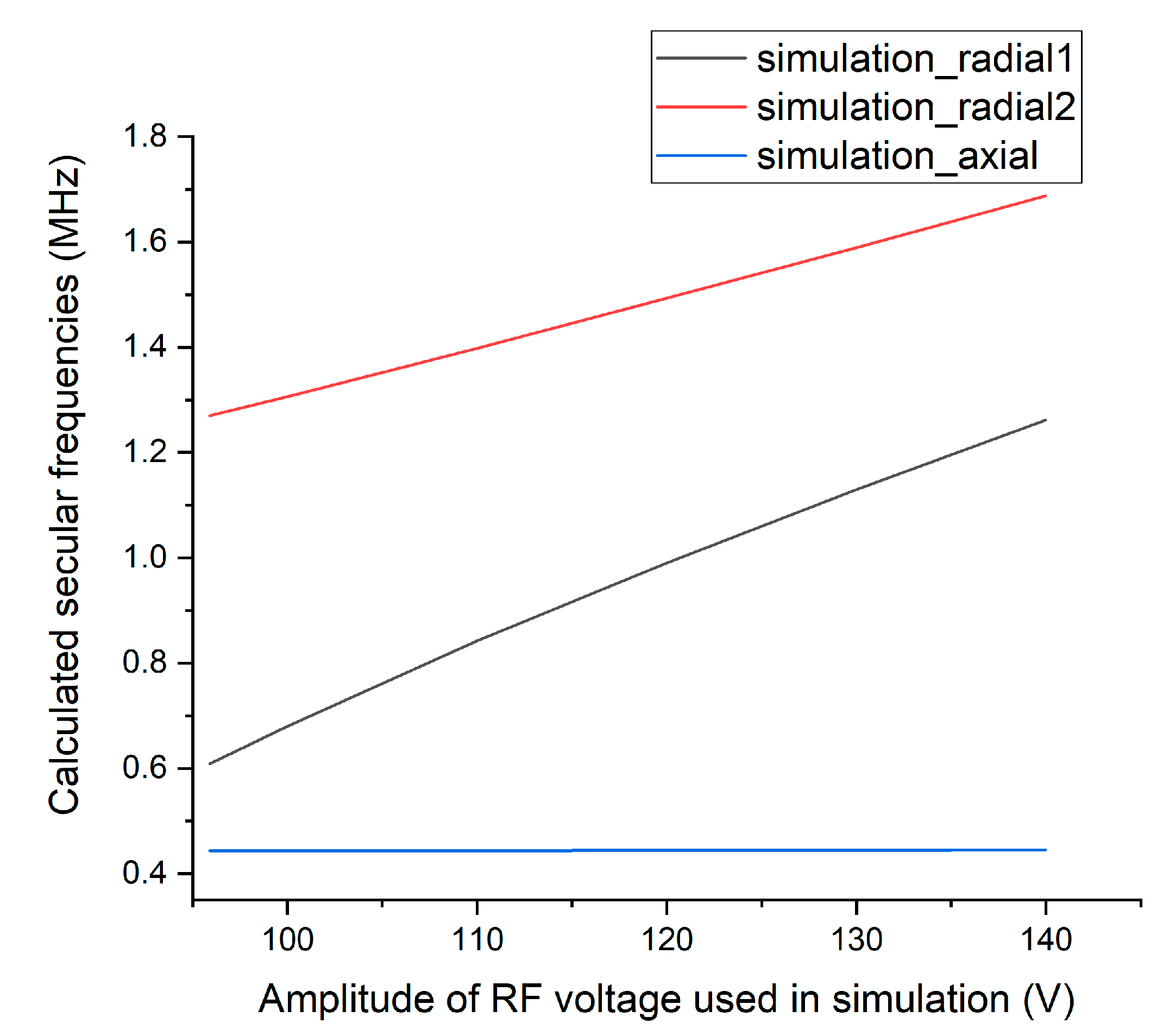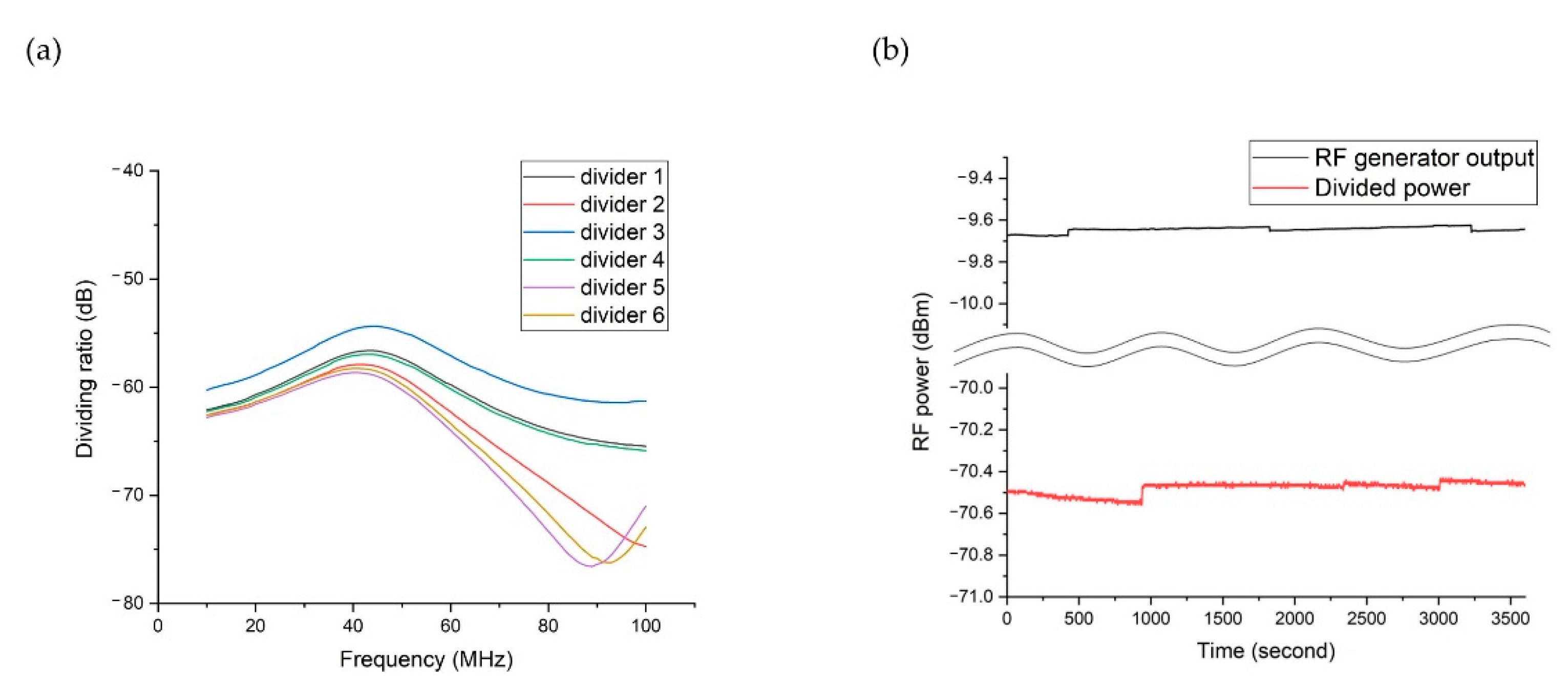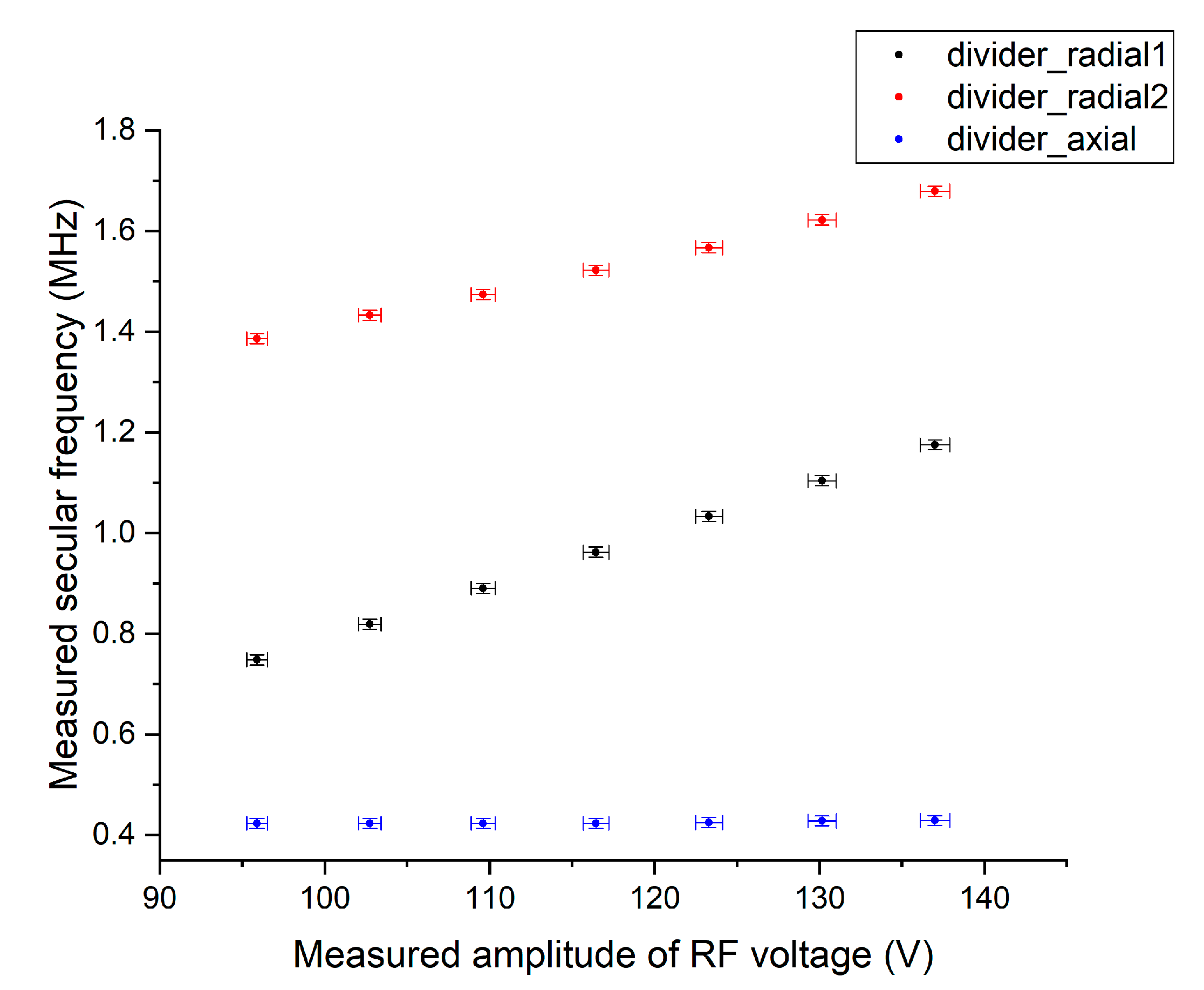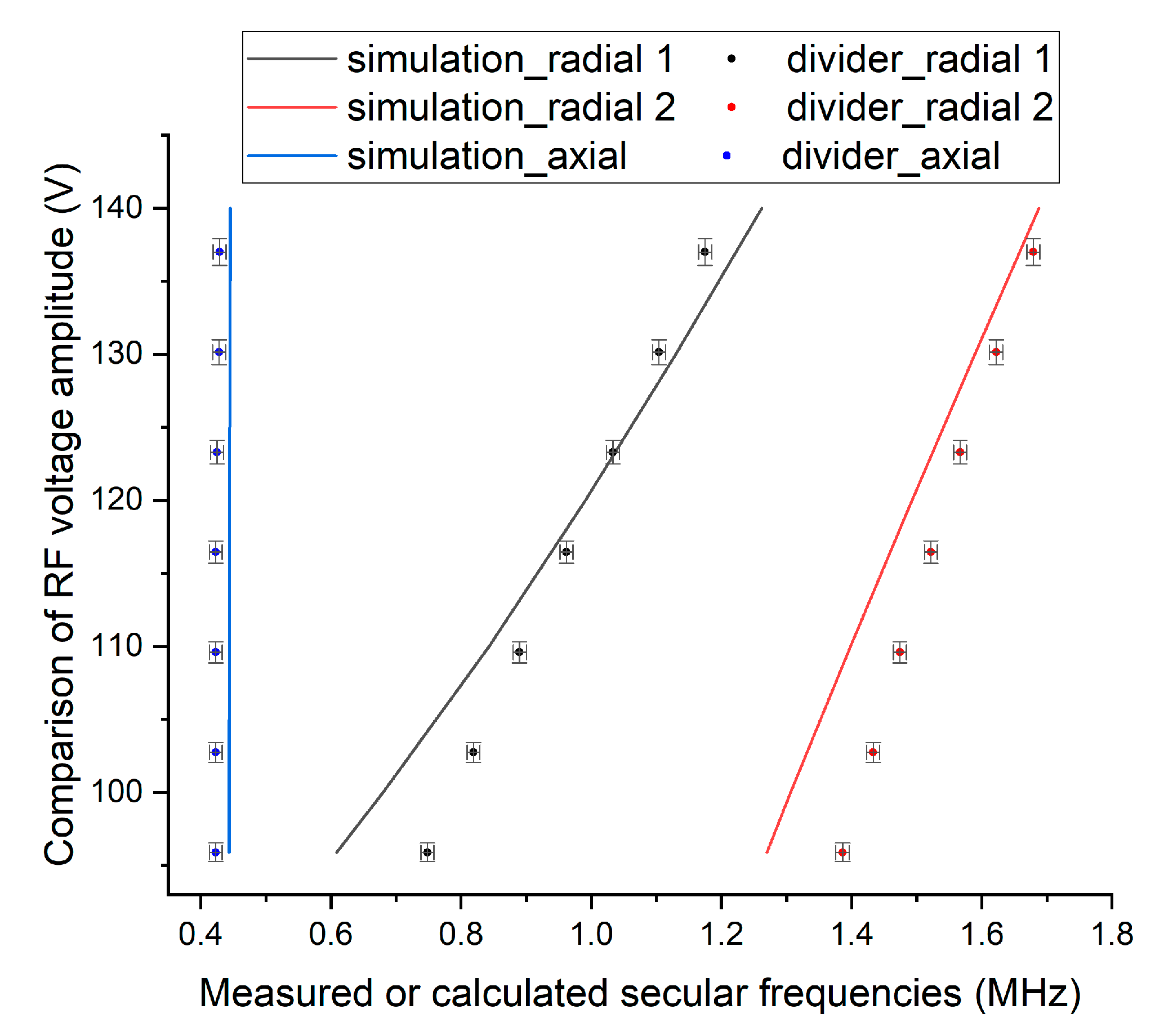A New Measurement Method for High Voltages Applied to an Ion Trap Generated by an RF Resonator
Abstract
:1. Introduction
2. Experimental Background
2.1. Surface Ion Trap and Vacuum Chamber
2.2. Numerical Simulation
2.3. Voltage Divider Design
3. Experimental Methods and Results
3.1. Voltage Divider Characterization
3.2. Construction of the Divider and the Helical Resonator
3.3. Measurement of Secular Frequencies
3.4. Relation between Measured Voltages and Measured Secular Frequencies
4. Discussion and Conclusions
Author Contributions
Funding
Institutional Review Board Statement
Informed Consent Statement
Data Availability Statement
Acknowledgments
Conflicts of Interest
References
- Cirac, J.I.; Zoller, P. Quantum computations with cold trapped ions. Phys. Rev. Lett. 1995, 74, 4091. [Google Scholar] [CrossRef] [PubMed]
- Blatt, R.; Wineland, D. Entangled states of trapped atomic ions. Nature 2008, 453, 1008–1015. [Google Scholar] [CrossRef]
- Mølmer, K.; Sørensen, A. Multiparticle entanglement of hot trapped ions. Phys. Rev. Lett. 1999, 82, 1835. [Google Scholar] [CrossRef] [Green Version]
- Sørensen, A.; Mølmer, K. Quantum computation with ions in thermal motion. Phys. Rev. Lett. 1999, 82, 1971. [Google Scholar] [CrossRef] [Green Version]
- Häffner, H.; Roos, C.F.; Blatt, R. Quantum computing with trapped ions. Phys. Rep. 2008, 469, 155–203. [Google Scholar] [CrossRef] [Green Version]
- Moehring, D.L.; Maunz, P.; Olmschenk, S.; Younge, K.C.; Matsukevich, D.N.; Duan, L.M.; Monroe, C. Entanglement of single-atom quantum bits at a distance. Nature 2007, 449, 68–71. [Google Scholar] [CrossRef]
- Monz, T.; Nigg, D.; Martinez, E.A.; Brandl, M.F.; Schindler, P.; Rines, R.; Wang, S.X.; Chuang, I.L.; Blatt, R. Realization of a scalable Shor algorithm. Science 2016, 351, 1068–1070. [Google Scholar] [CrossRef] [Green Version]
- Wright, K.; Beck, K.M.; Debnath, S.; Amini, J.M.; Nam, Y.; Grzesiak, N.; Chen, J.S.; Pisenti, N.C.; Chmielewski, M.; Collins, C.; et al. Benchmarking an 11-qubit quantum computer. Nat. Commun. 2019, 10, 1–6. [Google Scholar] [CrossRef]
- Wang, Y.; Um, M.; Zhang, J.; An, S.; Lyu, M.; Zhang, J.N.; Duan, L.M.; Yum, D.; Kim, K. Single-qubit quantum memory exceeding ten-minute coherence time. Nat. Photonics 2017, 11, 646–650. [Google Scholar] [CrossRef]
- Johnson, K.G.; Wong-Campos, J.D.; Restelli, A.; Landsman, K.A.; Neyenhuis, B.; Mizrahi, J.; Monroe, C. Active stabilization of ion trap radiofrequency potentials. Rev. Sci. Instrum. 2016, 87, 053110. [Google Scholar] [CrossRef]
- Kaushal, V.; Lekitsch, B.; Stahl, A.; Hilder, J.; Pijn, D.; Schmiegelow, C.; Bermudez, A.; Müller, M.; Schmidt-Kaler, F.; Poschinger, U. Shuttling-based trapped-ion quantum information processing. AVS Quantum. Sci. 2020, 2, 014101. [Google Scholar] [CrossRef] [Green Version]
- Pagano, G.; Hess, P.W.; Kaplan, H.B.; Tan, W.L.; Richerme, P.; Becker, P.; Kyprianidis, A.; Zhang, J.; Birckelbaw, E.; Hernandez, M.R.; et al. Cryogenic trapped-ion system for large scale quantum simulation. Quantum Sci. Technol. 2018, 4, 014004. [Google Scholar] [CrossRef]
- Hahn, H.; Zarantonello, G.; Schulte, M.; Bautista-Salvador, A.; Hammerer, K.; Ospelkaus, C. Integrated 9Be+ multi-qubit gate device for the ion-trap quantum computer. NPJ Quantum Inf. 2019, 5, 1–5. [Google Scholar] [CrossRef]
- Ohira, R.; Mukaiyama, T.; Toyoda, K. Breaking rotational symmetry in a trapped-ion quantum tunneling rotor. Phys. Rev. A 2020, 101, 022106. [Google Scholar] [CrossRef] [Green Version]
- Leibfried, D.; Blatt, R.; Monroe, C.; Wineland, D. Quantum dynamics of single trapped ions. Rev. Mod. Phys. 2003, 75, 281. [Google Scholar] [CrossRef] [Green Version]
- Gandolfi, D.; Niedermayr, M.; Kumph, M.; Brownnutt, M.; Blatt, R. Compact radio-frequency resonator for cryogenic ion traps. Rev. Sci. Instrum. 2012, 83, 084705. [Google Scholar] [CrossRef] [Green Version]
- Macalpine, W.W.; Schildknecht, R.O. Coaxial resonators with helical inner conductor. Proc. IRE 1959, 47, 2099–2105. [Google Scholar] [CrossRef]
- Madsen, M.J. Advanced Ion Trap Development and Ultrafast Laser-Ion Interactions. Ph.D. Thesis, University of Michigan, Washtenaw County, MI, USA, 2006. [Google Scholar]
- Siverns, J.D.; Simkins, L.R.; Weidt, S.; Hensinger, W.K. On the application of radio frequency voltages to ion traps via helical resonators. Appl. Phys. B 2012, 107, 921–934. [Google Scholar] [CrossRef] [Green Version]
- Kielpinski, D.; Monroe, C.; Wineland, D.J. Architecture for a large-scale ion-trap quantum computer. Nature 2002, 417, 709–711. [Google Scholar] [CrossRef] [Green Version]
- Monroe, C.; Kim, J. Scaling the ion trap quantum processor. Science 2013, 339, 1164–1169. [Google Scholar] [CrossRef] [PubMed] [Green Version]
- Amini, J.M.; Uys, H.; Wesenberg, J.H.; Seidelin, S.; Britton, J.; Bollinger, J.J.; Wineland, D.J. Toward scalable ion traps for quantum information processing. New J. Phys. 2010, 12, 033031. [Google Scholar] [CrossRef]
- Wright, K.; Amini, J.M.; Faircloth, D.L.; Volin, C.; Doret, S.C.; Hayden, H.; Slusher, R.E. Reliable transport through a microfabricated X-junction surface-electrode ion trap. New J. Phys. 2013, 15, 033004. [Google Scholar] [CrossRef] [Green Version]
- Shu, G.; Vittorini, G.; Buikema, A.; Nichols, C.S.; Volin, C.; Stick, D.; Brown, K.R. Heating rates and ion-motion control in a Y-junction surface-electrode trap. Phys. Rev. A 2014, 89, 062308. [Google Scholar] [CrossRef] [Green Version]
- Seidelin, S.; Chiaverini, J.; Reichle, R.; Bollinger, J.J.; Leibfried, D.; Britton, J.; Itano, W.M. Microfabricated surface-electrode ion trap for scalable quantum information processing. Phys. Rev. Lett. 2006, 96, 253003. [Google Scholar] [CrossRef] [PubMed] [Green Version]
- Moehring, D.L.; Highstrete, C.; Stick, D.; Fortier, K.M.; Haltli, R.; Tigges, C.; Blain, M.G. Design, fabrication and experimental demonstration of junction surface ion traps. New J. Phys. 2011, 13, 075018. [Google Scholar] [CrossRef] [Green Version]
- Hong, S.; Kwon, Y.; Jung, C.; Lee, M.; Kim, T.; Cho, D.D. A new microfabrication method for ion-trap chips that reduces exposure of dielectric surfaces to trapped ions. J. Microelectromech. Syst. 2017, 27, 28–30. [Google Scholar] [CrossRef]
- Hughes, M.D.; Lekitsch, B.; Broersma, J.A.; Hensinger, W.K. Microfabricated ion traps. Contemp. Phys. 2011, 52, 505–529. [Google Scholar] [CrossRef]
- Sterling, R.C.; Rattanasonti, H.; Weidt, S.; Lake, K.; Srinivasan, P.; Webster, S.C.; Hensinger, W.K. Fabrication and operation of a two-dimensional ion-trap lattice on a high-voltage microchip. Nat. Commun. 2014, 5, 1–6. [Google Scholar] [CrossRef] [Green Version]
- Detti, A.; De Pas, M.; Duca, L.; Perego, E.; Sias, C. A compact radiofrequency drive based on interdependent resonant circuits for precise control of ion traps. Rev. Sci. Instrum. 2019, 90, 023201. [Google Scholar] [CrossRef] [Green Version]
- Sharma, L.; Roy, A.; Panja, S.; Ojha, V.N.; De, S. Estimation of the ion-trap assisted electrical loads and resulting BBR shift. Sci. Rep. 2018, 8, 1–10. [Google Scholar] [CrossRef]
- Apriyana, A.A.A.; Li, H.; Zhao, P.; Tao, J.; Lim, Y.D.; Lin, Y.; Guidoni, L.; Tan, C.S. Design and Development of Single-Qubit Ion Trap on Glass and Si Substrates With RF Analysis and Performance Benchmarking. IEEE Trans. Compon. Packag. Manuf. Technol. 2020, 10, 1221–1231. [Google Scholar] [CrossRef]
- Nizamani, A.H.; Rind, M.A.; Shaikh, N.M.; Moghal, A.H.; Saleem, H. Versatile ultra high vacuum system for ion trap experiments: Design and implementation. Int. J. Adv. Res. Technol. 2013, 2, 502–510. [Google Scholar]
- Rastogi, A.; Batra, N.; Roy, A.; Thangjam, J.; Kalsi, V.P.S.; Panja, S.; De, S. Design of the Ion Trap and Vacuum System for 171 Yb-ion Optical Frequency Standard. MAPAN J. Metrol. Soc. India 2015, 30, 169–174. [Google Scholar]
- Hong, S.; Lee, M.; Cheon, H.; Kim, T.; Cho, D.D. Guidelines for designing surface ion traps using the boundary element method. Sensors 2016, 16, 616. [Google Scholar] [CrossRef] [PubMed] [Green Version]
- Hong, S.; Lee, M.; Kwon, Y.D.; Cho, D.D.; Kim, T. Experimental methods for trapping ions using microfabricated surface ion traps. J. Vis. Exp. 2017, 126, e56060. [Google Scholar] [CrossRef] [PubMed] [Green Version]
- Pearson, C.E.; Leibrandt, D.R.; Bakr, W.S.; Mallard, W.J.; Brown, K.R.; Chuang, I.L. Experimental investigation of planar ion traps. Phys. Rev. A 2006, 73, 032307. [Google Scholar] [CrossRef] [Green Version]
- Li, M.; Liu, X.; Zhou, X.; Ouyang, Z. Ion-Neutral Collision Effects on Ion Trapping and Pseudopotential Depth in Ion Trap Mass Spectrometry. J. Am. Soc. Mass Spectr. 2019, 30, 2750–2755. [Google Scholar] [CrossRef]
- Deng, K.; Sun, Y.L.; Yuan, W.H.; Xu, Z.T.; Zhang, J.; Lu, Z.H.; Luo, J. A modified model of helical resonator with predictable loaded resonant frequency and Q-factor. Rev. Sci. Instrum. 2014, 85, 104706. [Google Scholar] [CrossRef] [PubMed]
- Ibaraki, Y.; Tanaka, U.; Urabe, S. Detection of parametric resonance of trapped ions for micromotion compensation. Appl. Phys. B 2011, 105, 219–223. [Google Scholar] [CrossRef]
- Cubric, D.; Lencova, B.; Read, F.H.; Zlamal, J. Comparison of FDM, FEM and BEM for electrostatic charged particle optics. Nucl. Instrum. Methods Phys. Res. A 1999, 427, 357–362. [Google Scholar] [CrossRef]
- Brkić, B.; Taylor, S.; Ralph, J.F.; France, N. High-fidelity simulations of ion trajectories in miniature ion traps using the boundary-element method. Phys. Rev. A 2006, 73, 012326. [Google Scholar] [CrossRef] [Green Version]
- Imreh, G. Implementing Segmented Ion Trap Designs for Quantum Computing. Ph.D. Thesis, University of Oxford, Oxford, UK, 2008. [Google Scholar]
- Pauli, A. Classical Control of an Ion in a Surface Trap. Master’s Thesis, University of Innsbruck, Innsbruck, Austria, 2011. [Google Scholar]
- Fischer, C. Optical Trapping in a Build-Up Cavity. Master’s Thesis, ETH Zürich, Zürich, Switzerland, 2015. [Google Scholar]
- Fanghaenel, S.; Asvany, O.; Schlemmer, S. Modeling; Optimizing RF Multipole Ion Traps. In Proceedings of the International Symposium on Molecular Spectroscopy, Champaign-Urbana, IL, USA, 20–24 June 2016. [Google Scholar]
- Singer, K.; Poschinger, U.; Murphy, M.; Ivanov, P.; Ziesel, F.; Calarco, T.; Schmidt-Kaler, F. Colloquium: Trapped ions as quantum bits: Essential numerical tools. Rev. Mod. Phys. 2010, 82, 2609. [Google Scholar] [CrossRef] [Green Version]
- Lekitsch, B.; Weidt, S.; Fowler, A.G.; Mølmer, K.; Devitt, S.J.; Wunderlich, C.; Hensinger, W.K. Blueprint for a microwave trapped ion quantum computer. Sci. Adv. 2017, 3, e1601540. [Google Scholar] [CrossRef] [PubMed] [Green Version]











Publisher’s Note: MDPI stays neutral with regard to jurisdictional claims in published maps and institutional affiliations. |
© 2021 by the authors. Licensee MDPI, Basel, Switzerland. This article is an open access article distributed under the terms and conditions of the Creative Commons Attribution (CC BY) license (http://creativecommons.org/licenses/by/4.0/).
Share and Cite
Park, Y.; Jung, C.; Seong, M.; Lee, M.; Cho, D.D.; Kim, T. A New Measurement Method for High Voltages Applied to an Ion Trap Generated by an RF Resonator. Sensors 2021, 21, 1143. https://doi.org/10.3390/s21041143
Park Y, Jung C, Seong M, Lee M, Cho DD, Kim T. A New Measurement Method for High Voltages Applied to an Ion Trap Generated by an RF Resonator. Sensors. 2021; 21(4):1143. https://doi.org/10.3390/s21041143
Chicago/Turabian StylePark, Yunjae, Changhyun Jung, Myeongseok Seong, Minjae Lee, Dongil Dan Cho, and Taehyun Kim. 2021. "A New Measurement Method for High Voltages Applied to an Ion Trap Generated by an RF Resonator" Sensors 21, no. 4: 1143. https://doi.org/10.3390/s21041143
APA StylePark, Y., Jung, C., Seong, M., Lee, M., Cho, D. D., & Kim, T. (2021). A New Measurement Method for High Voltages Applied to an Ion Trap Generated by an RF Resonator. Sensors, 21(4), 1143. https://doi.org/10.3390/s21041143






